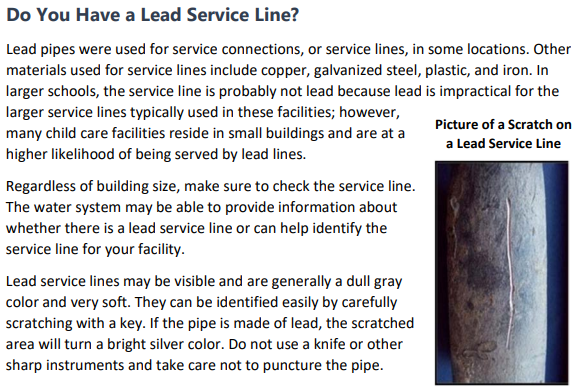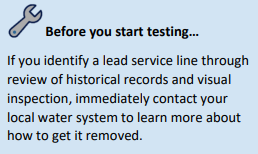
EPA Updates its 3Ts Guidance for Reducing Lead in Drinking Water
Lindsay McCormick, is a Project Manager. Tom Neltner, J.D., is the Chemicals Policy Director.
Earlier this month, EPA released its updated 3Ts for Reducing Lead in Drinking Water Toolkit, which provides guidance for schools and child care facilities seeking to ensure children are safe from lead in water. The new 3Ts – an update to the agency’s 2006 guidance – is now a web-based toolkit that includes modules, customizable templates, and factsheets.
Overall, the new toolkit is an improvement. While the protocol itself is largely the same, the new toolkit is more user friendly and written for the non-technical audience, making it more likely that school and child care staff will use it. EPA has also reframed the toolkit from “Training, Testing, and Telling” to “Training, Testing, and Taking Action” – placing more emphasis on the critical step of addressing lead sources than the previous version. “Telling” is now integrated throughout the entire toolkit to highlight the importance of communication at every step. The agency has also developed a helpful flushing best practices factsheet, which is a topic that often causes considerable confusion.
In EDF’s June 2018 report on our pilot of 11 child care facilities, “Tackling lead in water at child care facilities,” we recommended EPA update its 2006 guidance to address four key gaps. The agency has made progress on the two most important of those but leaves the other two unresolved. The most important change to the guidance is that the agency has removed the 20 parts per billion (ppb) action level and instead recommends action whenever there are “elevated lead levels.” While EPA does not define an elevated lead level, a deep dive into the appendix suggests that levels over 5 ppb warrant follow-up. The updated guidance also puts a greater emphasis on the identification of lead service lines (LSLs) and includes LSL replacement as a permanent control measure, though not as an explicit recommendation. Further, the agency did not update the protocol to deal with challenges posed by aerator cleaning and hot water heaters. Below we explore each of these issues in further detail.
Action level
The decade-old 3Ts guidance used an action level to trigger remediation of 20 ppb, a level that EPA recognizes is not based on health risks. In our report, we recommended that EPA lower its action level from 20 ppb to 5 ppb as an interim measure – further lowering it once NSF International’s leachability standard (which allows new brass fixtures to leach up to 5 ppb of lead) is updated. We argued that a lower action level at child care facilities may be even more prudent than schools because they serve younger children that are more vulnerable to harm from lead.
In its update, EPA has removed the 20 ppb action level from the toolkit but has not recommended a new action level. The guidance states, “If testing results show elevated levels of lead in drinking water, then you should implement remediation measures,” but EPA does not define “elevated lead level” anywhere in the toolkit. The person using the toolkit is expected to define the term. This strategy gives considerable leeway to schools and child cares to identify an appropriate action level for themselves (if their state or city has not already established one) – and has the potential to cause confusion.
EPA does, however, provide some benchmarks illustrated through examples in the toolkit. The agency describes 1 ppb as “close to the detection level” (page 39). Since lead is rarely found in source water, presumably, any level greater than detection is elevated. For additional clues, we reviewed Appendix D, which is designed to help the user pinpoint the source of lead, and found the following:
- “If the lead level … is lower, close to 5 ppb, then very little lead is coming from the plumbing upstream of the faucet.” (page 62, emphasis added)
- “If the lead level … significantly exceeds 5 ppb (for example, 10 ppb), then lead in the drinking water could also be contributed by the plumbing upstream [.]” (page 61, emphasis added)
- “If the lead level … is very high (above 20 ppb), then there could be lead sources upstream … and you may need to contact a plumber.” (page 66, emphasis added)
Through these examples, EPA implies that 5 ppb is a low level of lead that does not warrant follow-up while 10 ppb and 20 ppb are significant enough to warrant investigation and possible remediation.
Lead service lines
The earlier guidance gave little attention to identifying and removing LSLs. When LSLs are present, they are the largest contributor of lead in water. In 2016, EPA’s National Drinking Water Advisory Council recommended that the agency make LSL replacement a priority. In our report, we explain that child care facilities are more likely to have LSLs than schools because they are often located in smaller buildings or homes. We recommended that EPA update its 3Ts guidance to place a greater emphasis on LSL identification and replacement – particularly for child care. Because LSLs can unpredictably release lead, we recommended that LSLs be identified and replaced without regard to water sampling results.
EPA’s update embraces this recommendation, including a new section called “Do you have a lead service line?” (page 32, see image below). This succinct, but helpful, section explains the discrepancy between schools and child care, but recommends that “[r]egardless of building size, make sure to check the service line.” The toolkit explains that the water system may be able to identify the service line material or the facility can check themselves through a scratch test.

LSL replacement is included as a permanent remediation option under the “Taking Action” section in the toolkit. However, the agency has retained the passive language from the earlier version – not making an explicit recommendation for LSL replacement, even though such a recommendation is made for removal of lead-lined water coolers.

The agency does, however, go a step further in its new factsheets for child care facilities and tribal schools. Each of these factsheets has a prominent box (see to the right) that makes a strong statement recommending LSL replacement.
Aerator cleaning
In our pilot, we found that aerator cleaning, without special precautions, could increase lead levels. We hypothesized that cleaning the aerators disturbed lead particulates stuck in the aerator screen without fully flushing them out, causing lead levels to increase. We therefore recommended (albeit did not test) soaking aerators in vinegar as part of the cleaning process, as a weak acid should help dissolve such lead particulates. We recognize further research is needed in this area; however, we are concerned that EPA’s updated toolkit does not provide a robust protocol for aerator cleaning or at least caution the reader that increased levels are possible and further research is needed.
Water heaters
In our pilot study, we also found that water heaters may function as lead traps. We found lead in every water heater we tested – with one sample as high as 2,680 ppb. Luckily, hot water samples at the taps were not notably different than cold water samples, so it is unclear whether the high levels found in water heaters ultimately end up at the tap. EPA deals with this issue in the updated guidance by stating “Although EPA encourages routine maintenance of hot water heaters, this guidance does not include sampling hot water outlets or hot water heaters, because hot water is not recommended for consumption (drinking/cooking).” We do not think that avoiding hot water is a realistic solution. While additional research is needed before evidence-based guidance can be developed, we hope EPA will address hot water and water heaters in its next update to the 3Ts toolkit.
Conclusions
In sum, the EPA’s updated 3Ts toolkit is an improvement, at least partially addressing our two major areas of concern by removing the 20 ppb action level and including steps for identifying and replacing LSLs.
Importantly, EPA linked its release with a new $20 million grant program designed to support voluntary lead in drinking water testing programs in schools and child care facilities across the country. EPA is asking that states applying for the funding prioritize child care facilities, as they serve children at a more vulnerable life stage than schools. Unfortunately, Congress limited the funding to only the “Training” and “Testing” steps, excluding the critical “Taking Action” step to address lead sources identified. Providing states with this funding is important – but testing alone will not make water safer. Despite this limitation, schools and child care facilities must prioritize all three Ts, including “Taking Action.”












